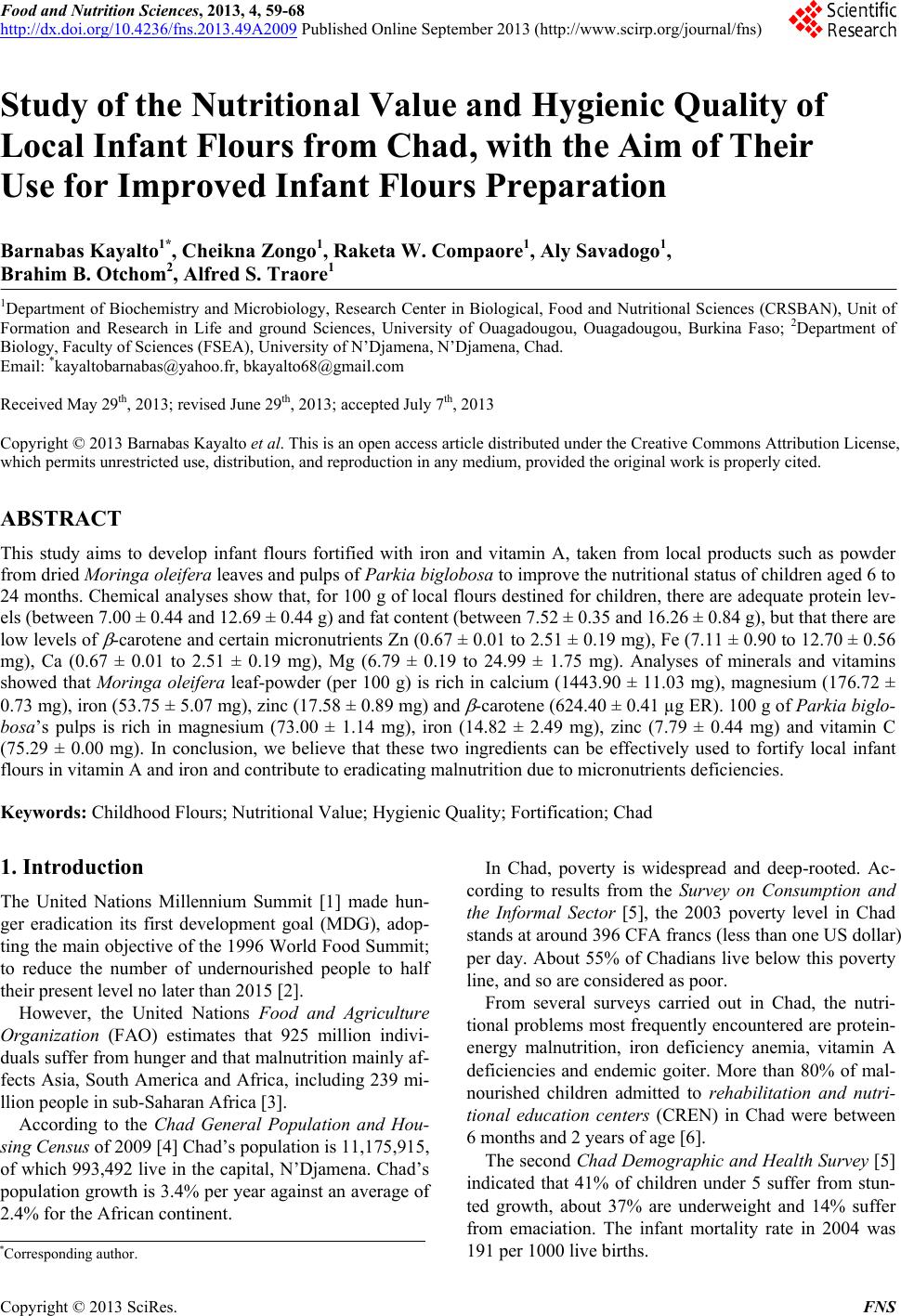 Food and Nutrition Sciences, 2013, 4, 59-68 http://dx.doi.org/10.4236/fns.2013.49A2009 Published Online September 2013 (http://www.scirp.org/journal/fns) Study of the Nutritional Value and Hygienic Quality of Local Infant Flours from Chad, with the Aim of Their Use for Improved Infant Flours Preparation Barnabas Kayalto1*, Cheikna Zongo1, Raketa W. Compaore1, Aly Savadogo1, Brahim B. Otchom2, Alfred S. Traore1 1Department of Biochemistry and Microbiology, Research Center in Biological, Food and Nutritional Sciences (CRSBAN), Unit of Formation and Research in Life and ground Sciences, University of Ouagadougou, Ouagadougou, Burkina Faso; 2Department of Biology, Faculty of Sciences (FSEA), University of N’Djamena, N’Djamena, Chad. Email: *kayaltobarnabas@yahoo.fr, bkayalto68@gmail.com Received May 29th, 2013; revised June 29th, 2013; accepted July 7th, 2013 Copyright © 2013 Barnabas Kayalto et al. This is an open access article distributed under the Creative Commons Attribution License, which permits unrestricted use, distribution, and reproduction in any medium, provided the original work is properly cited. ABSTRACT This study aims to develop infant flours fortified with iron and vitamin A, taken from local products such as powder from dried Moringa oleifera leaves and pulps of Parkia biglobosa to improve the nutritional status of children aged 6 to 24 months. Chemical analyses show that, for 100 g of local flours destined for children, there are adequate protein lev- els (between 7.00 ± 0.44 and 12.69 ± 0.44 g) and fat content (between 7.52 ± 0.35 and 16.26 ± 0.84 g), but that there are low levels of -carotene and certain micronutrients Zn (0.67 ± 0.01 to 2.51 ± 0.19 mg), Fe (7.11 ± 0.90 to 12.70 ± 0.56 mg), Ca (0.67 ± 0.01 to 2.51 ± 0.19 mg), Mg (6.79 ± 0.19 to 24.99 ± 1.75 mg). Analyses of minerals and vitamins showed that Moringa oleifera leaf-powder (per 100 g) is rich in calcium (1443.90 ± 11.03 mg), magnesium (176.72 ± 0.73 mg), iron (53.75 ± 5.07 mg), zinc (17.58 ± 0.89 mg) and -carotene (624.40 ± 0.41 µg ER). 100 g of Parkia biglo- bosa’s pulps is rich in magnesium (73.00 ± 1.14 mg), iron (14.82 ± 2.49 mg), zinc (7.79 ± 0.44 mg) and vitamin C (75.29 ± 0.00 mg). In conclusion, we believe that these two ingredients can be effectively used to fortify local infant flours in vitamin A and iron and contribute to eradicating malnutrition due to micronutrients deficiencies. Keywords: Childhood Flours; Nutritional Value; Hygienic Quality; Fortification; Chad 1. Introduction The United Nations Millennium Summit [1] made hun- ger eradication its first development goal (MDG), adop- ting the main objective of the 1996 World Food Summit; to reduce the number of undernourished people to half their present level no later than 2015 [2]. However, the United Nations Food and Agriculture Organization (FAO) estimates that 925 million indivi- duals suffer from hunger and that malnutrition mainly af- fects Asia, South America and Africa, including 239 mi- llion people in sub-Saharan Africa [3]. According to the Chad General Population and Hou- sing Census of 2009 [4] Chad’s population is 11,175,915, of which 993,492 live in the capital, N’Djamena. Chad’s population growth is 3.4% per year against an average of 2.4% for the African continent. In Chad, poverty is widespread and deep-rooted. Ac- cording to results from the Survey on Consumption and the Informal Sector [5], the 2003 poverty level in Chad stands at around 396 CFA francs (less than one US dollar) per day. About 55% of Chadians live below this poverty line, and so are considered as poor. From several surveys carried out in Chad, the nutri- tional problems most frequently encountered are protein- energy malnutrition, iron deficiency anemia, vitamin A deficiencies and endemic goiter. More than 80% of mal- nourished children admitted to rehabilitation and nutri- tional education centers (CREN) in Chad were between 6 months and 2 years of age [6]. The second Chad Demographic and Health Su rvey [5] indicated that 41% of children under 5 suffer from stun- ted growth, about 37% are underweight and 14% suffer from emaciation. The infant mortality rate in 2004 was 191 per 1000 live births. *Corresponding author. Copyright © 2013 SciRes. FNS 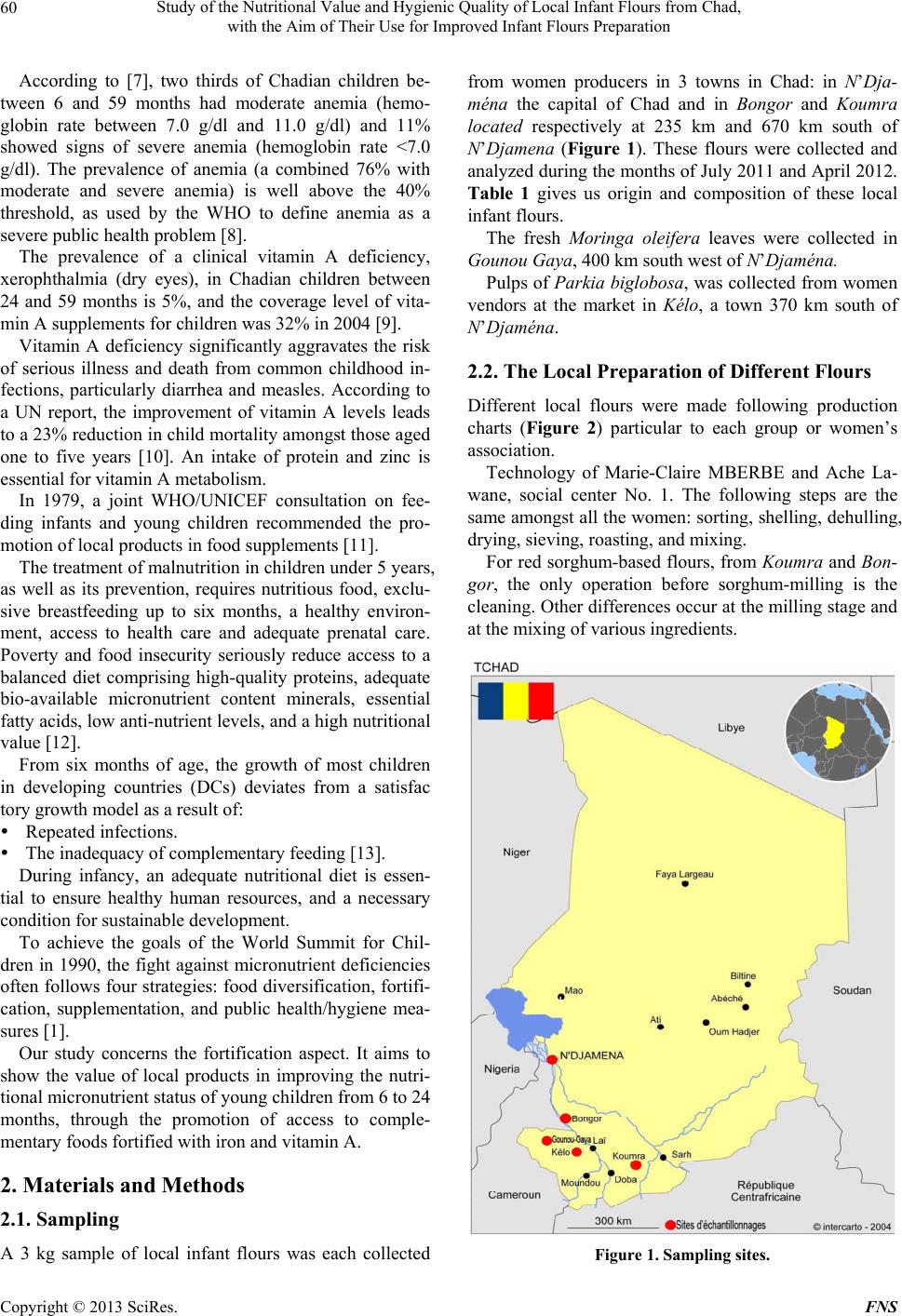 Study of the Nutritional Value and Hygienic Quality of Local Infant Flours from Chad, with the Aim of Their Use for Improved Infant Flours Preparation 60 According to [7], two thirds of Chadian children be- tween 6 and 59 months had moderate anemia (hemo- globin rate between 7.0 g/dl and 11.0 g/dl) and 11% showed signs of severe anemia (hemoglobin rate <7.0 g/dl). The prevalence of anemia (a combined 76% with moderate and severe anemia) is well above the 40% threshold, as used by the WHO to define anemia as a severe public health problem [8]. The prevalence of a clinical vitamin A deficiency, xerophthalmia (dry eyes), in Chadian children between 24 and 59 months is 5%, and the coverage level of vita- min A supplements for children was 32% in 2004 [9]. Vitamin A deficiency significantly aggravates the risk of serious illness and death from common childhood in- fections, particularly diarrhea and measles. According to a UN report, the improvement of vitamin A levels leads to a 23% reduction in child mortality amongst those aged one to five years [10]. An intake of protein and zinc is essential for vitamin A metabolism. In 1979, a joint WHO/UNICEF consultation on fee- ding infants and young children recommended the pro- motion of local products in food supplements [11]. The treatment of malnutrition in children under 5 years, as well as its prevention, requires nutritious food, exclu- sive breastfeeding up to six months, a healthy environ- ment, access to health care and adequate prenatal care. Poverty and food insecurity seriously reduce access to a balanced diet comprising high-quality proteins, adequate bio-available micronutrient content minerals, essential fatty acids, low anti-nutrient levels, and a high nutritional value [12]. From six months of age, the growth of most children in developing countries (DCs) deviates from a satisfac tory growth model as a result of: Repeated infections. The inadequacy of complementary feeding [13]. During infancy, an adequate nutritional diet is essen- tial to ensure healthy human resources, and a necessary condition for sustainable development. To achieve the goals of the World Summit for Chil- dren in 1990, the fight against micronutrient deficiencies often follows four strategies: food diversification, fortifi- cation, supplementation, and public health/hygiene mea- sures [1]. Our study concerns the fortification aspect. It aims to show the value of local products in improving the nutri- tional micronutrient status of young children from 6 to 24 months, through the promotion of access to comple- mentary foods fortified with iron and vitamin A. 2. Materials and Methods 2.1. Sampling A 3 kg sample of local infant flours was each collected from women producers in 3 towns in Chad: in N’Dja- ména the capital of Chad and in Bongor and Koumra located respectively at 235 km and 670 km south of N’Djamena (Figure 1). These flours were collected and analyzed during the months of July 2011 and April 2012. Table 1 gives us origin and composition of these local infant flours. The fresh Moringa oleifera leaves were collected in Gounou Gaya, 400 km south west of N’Djaména. Pulps of Parkia biglobosa, was collected from women vendors at the market in Kélo, a town 370 km south of N’Djaména. 2.2. The Local Preparation of Different Flours Different local flours were made following production charts (Figure 2) particular to each group or women’s association. Technology of Marie-Claire MBERBE and Ache La- wane, social center No. 1. The following steps are the same amongst all the women: sorting, shelling, dehulling, drying, sieving, roasting, and mixing. For red sorghum-based flours, from Koumra and Bon- gor, the only operation before sorghum-milling is the cleaning. Other differences occur at the milling stage and at the mixing of various ingredients. Figure 1. Sampling sites. Copyright © 2013 SciRes. FNS 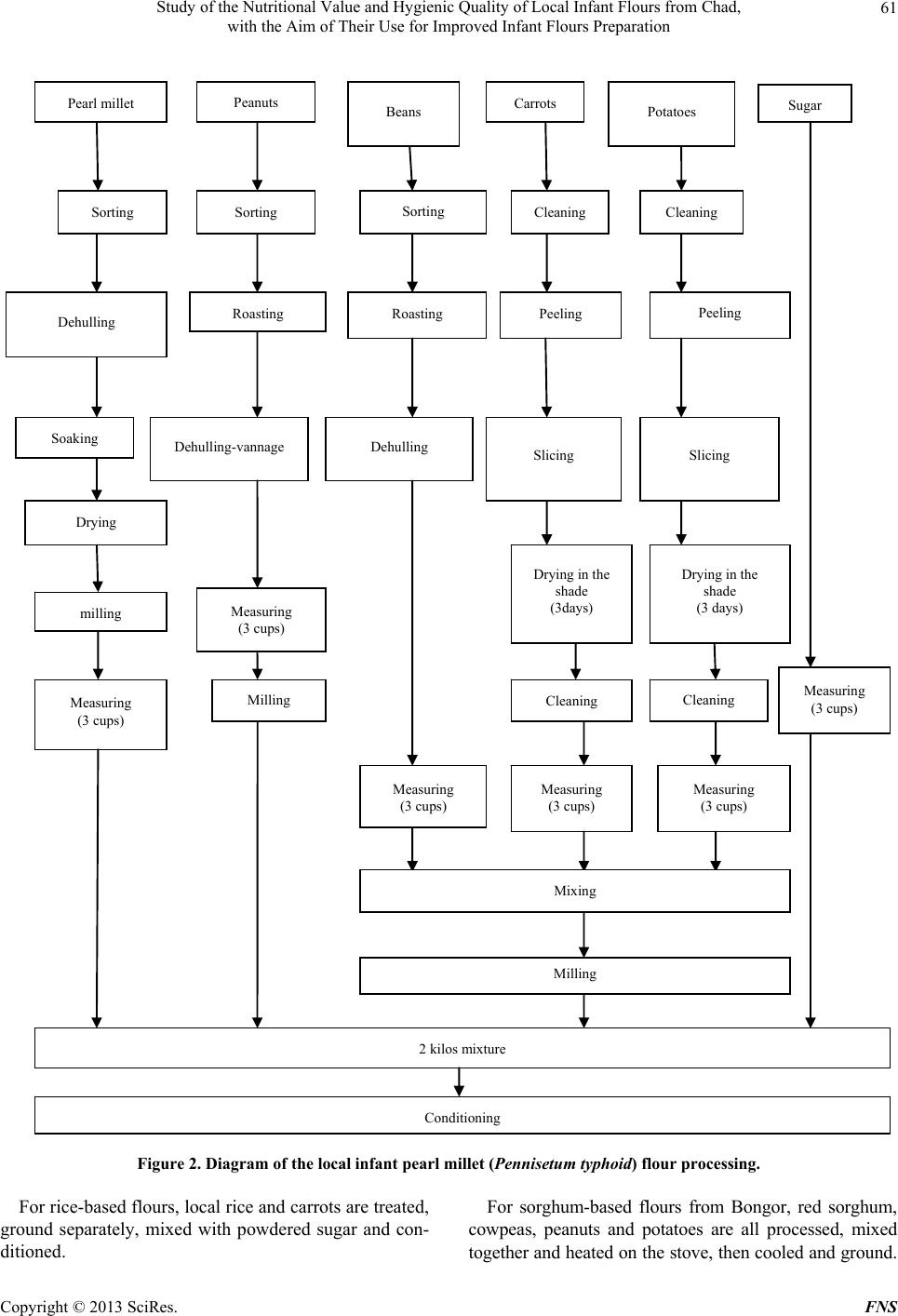 Study of the Nutritional Value and Hygienic Quality of Local Infant Flours from Chad, with the Aim of Their Use for Improved Infant Flours Preparation Copyright © 2013 SciRes. FNS 61 Pearl millet Peanuts Beans Carrots Potatoes Sugar Sorting Sorting Sorting Cleaning Cleaning Dehulling Soaking Drying milling Measuring (3 cups) 2 kilos mixture Conditioning Measuring (3 cups) Roasting Dehulling-vannage Measuring (3 cups) Milling Roasting Peeling Peeling Dehulling Slicing Slicing Measuring (3 cups) Drying in the shade (3days) Drying in the shade (3 days) Cleaning Cleaning Measuring (3 cups) Measuring (3 cups) Mixing Milling Figure 2. Diagram of the local infant pearl millet (Pennisetum typhoid) flour processing. For rice-based flours, local rice and carrots are treated, ground separately, mixed with powdered sugar and con- ditioned. For sorghum-based flours from Bongor, red sorghum, cowpeas, peanuts and potatoes are all processed, mixed together and heated on the stove, then cooled and ground. 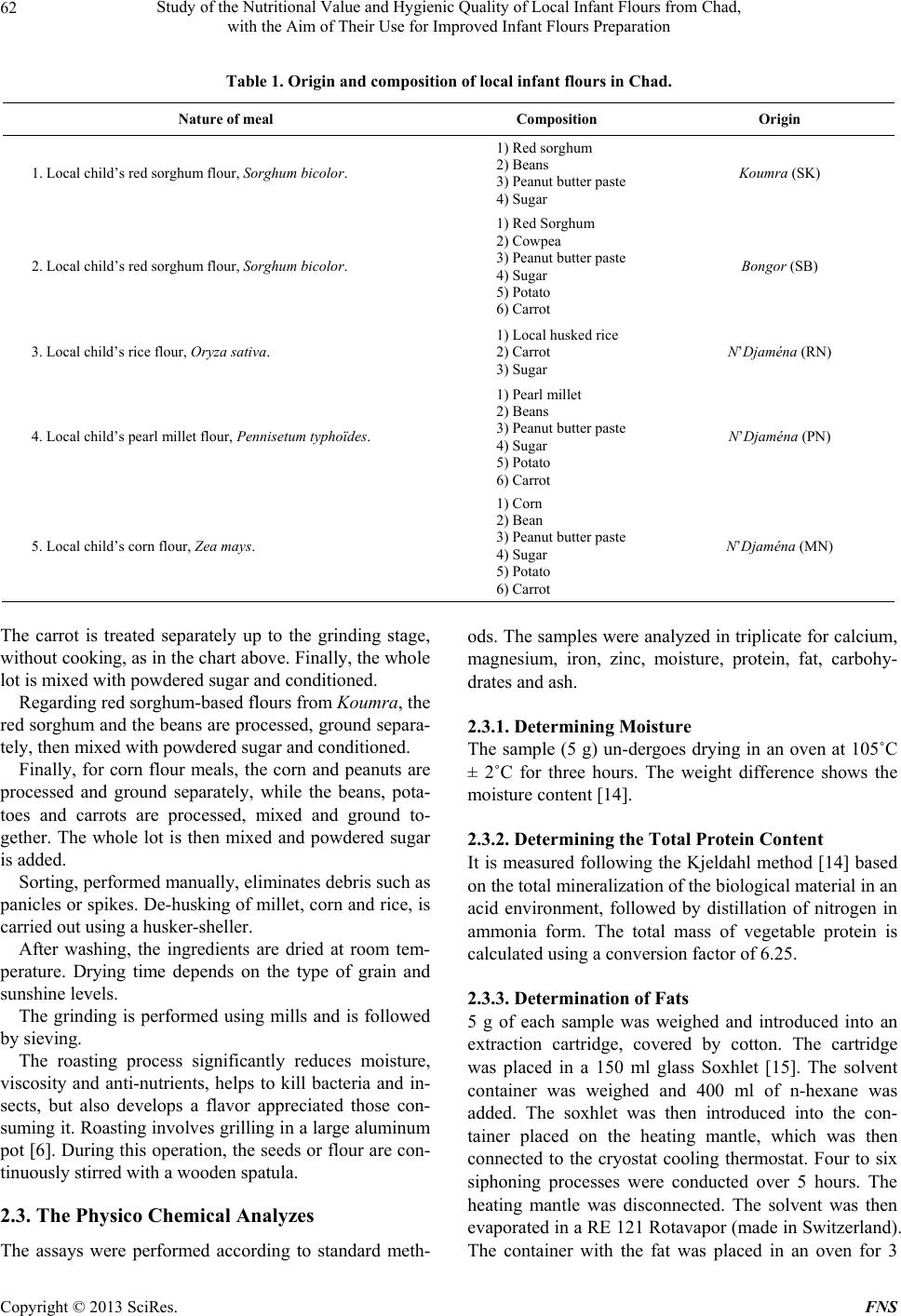 Study of the Nutritional Value and Hygienic Quality of Local Infant Flours from Chad, with the Aim of Their Use for Improved Infant Flours Preparation 62 Table 1. Origin and composition of local infant flours in Chad. Nature of meal Composition Origin 1. Local child’s red sorghum flour, Sorghum bicolor. 1) Red sorghum 2) Beans 3) Peanut butter paste 4) Sugar Koumra (SK) 2. Local child’s red sorghum flour, Sorghum bicolor. 1) Red Sorghum 2) Cowpea 3) Peanut butter paste 4) Sugar 5) Potato 6) Carrot Bongor (SB) 3. Local child’s rice flour, Oryza sativa. 1) Local husked rice 2) Carrot 3) Sugar N’Djaména (RN) 4. Local child’s pearl millet flour, Pennisetum typhoïdes. 1) Pearl millet 2) Beans 3) Peanut butter paste 4) Sugar 5) Potato 6) Carrot N’Djaména (PN) 5. Local child’s corn flour, Zea mays. 1) Corn 2) Bean 3) Peanut butter paste 4) Sugar 5) Potato 6) Carrot N’Djaména (MN) The carrot is treated separately up to the grinding stage, without cooking, as in the chart above. Finally, the whole lot is mixed with powdered sugar and conditioned. Regarding red sorghum-based flours from Koumra, the red sorghum and the beans are processed, ground separa- tely, then mixed with powdered sugar and conditioned. Finally, for corn flour meals, the corn and peanuts are processed and ground separately, while the beans, pota- toes and carrots are processed, mixed and ground to- gether. The whole lot is then mixed and powdered sugar is added. Sorting, performed manually, eliminates debris such as panicles or spikes. De-husking of millet, corn and rice, is carried out using a husker-sheller. After washing, the ingredients are dried at room tem- perature. Drying time depends on the type of grain and sunshine levels. The grinding is performed using mills and is followed by sieving. The roasting process significantly reduces moisture, viscosity and anti-nutrients, helps to kill bacteria and in- sects, but also develops a flavor appreciated those con- suming it. Roasting involves grilling in a large aluminum pot [6]. During this operation, the seeds or flour are con- tinuously stirred with a wooden spatula. 2.3. The Physico Chemical Analyzes The assays were performed according to standard meth- ods. The samples were analyzed in triplicate for calcium, magnesium, iron, zinc, moisture, protein, fat, carbohy- drates and ash. 2.3.1. Determining Moisture The sample (5 g) un-dergoes drying in an oven at 105˚C ± 2˚C for three hours. The weight difference shows the moisture content [14]. 2.3.2. Determining the Total Protein Content It is measured following the Kjeldahl method [14] based on the total mineralization of the biological material in an acid environment, followed by distillation of nitrogen in ammonia form. The total mass of vegetable protein is calculated using a conversion factor of 6.25. 2.3.3. Determination of Fats 5 g of each sample was weighed and introduced into an extraction cartridge, covered by cotton. The cartridge was placed in a 150 ml glass Soxhlet [15]. The solvent container was weighed and 400 ml of n-hexane was added. The soxhlet was then introduced into the con- tainer placed on the heating mantle, which was then connected to the cryostat cooling thermostat. Four to six siphoning processes were conducted over 5 hours. The heating mantle was disconnected. The solvent was then evaporated in a RE 121 Rotavapor (made in Switzerland). The container with the fat was placed in an oven for 3 Copyright © 2013 SciRes. FNS  Study of the Nutritional Value and Hygienic Quality of Local Infant Flours from Chad, with the Aim of Their Use for Improved Infant Flours Preparation 63 hours at 103˚C, and then in a desiccator for 30 min and then weighed. The weight difference gives the fat content of the sample. 2.3.4. Determination of Total Sugars The determination of the total sugar content of the sam- ples was performed in triplicate by spectrometric assay samples [16]. The reading of optical densities was made at 540 nm using a μquant type plate reader (Bio-tek in- strument Serial No. 157904, USA) coupled with a com- puter running KC integrated Junior (v1.31.5) software. 2.3.5. Determination of Ash Rate The sample (5 g) introduced in metal crucibles was min- eralized in a muffle furnace (type VOLCA V50) at 550˚C for five (05) hours, removed using thongs and then cooled in a desiccators for about one (01) hour before being weighed. The difference in weight gives the ash content of the sample [14]. 2.3.6. Determination of Minerals Mineralization was achieved through dry ashing. The ash obtained contains major elements (Na, Ca, Mg, K, etc.) and trace elements (Fe, Zn, etc.). These minerals were determined by Atomic Absorption Spectrometry [17] (with a PELKIN Elmer model 3110 device (Connecticut, USA). A hollow Al-Ca-Cu-Fe-Mg-Si-Zn cathode lamp was used. 2.3.7. Calculation of the Energy Value The energy value corresponding to the available energy was calculated using [18] coefficients, coefficients adop- ted by the United Nations Food and Agriculture Organi- zation (FAO) in 1970: 449XP GL Where P = protein percentage, G = carbohydrates per- centage, L = lipids (fats) percentage and X = energy value in Kcal/100g. 2.4. Microbiological Analyzes of Locally Made Infant Flours 2.4.1. Preparation of Samples for Analysis The stock solution for each parameter was prepared with 10 g of each sample (except for the detection of Salmo- nella, where 25 g of flour was used), aseptically removed and diluted in 90 ml of autoclaved Buffered Peptone Water (Liofilchem, Italy). The mixture is placed in a ster- ile stomacher bag that ensures the grinding for 2 minutes. The mix is put back in the flask, with a 10−1 dilution rate. A cascade dilution in autoclaved test tubes was done by taking 1 ml (or 1000 µl by the pipette) of the previous solution and putting it into 9 ml of NaCl. Dilutions of 10−2, 10−3, 10−4, 10−5 and 10−6 are then successfully ob- tained. Each time, the end of the test tube is subjected to flaming as soon as it is opened. After having added the 1000 µl, it is again subjected to flaming before being closed. There follows a process of autoclaving the test tubes (2 per sample) containing the Rappaport, to search for Sal- monella. Seeding was done by plating 200 µl of each aliquot taken. Each dilution was inoculated into two Petri dishes and incubated. 2.4.2. Numeration of the Total Aerobic Mesophilic Flora The total aerobic mesophilic flora (FAMT) was counted in PCA (Plate Count Agar Liofilchem, Italy) conditions, after 24 hours of incubation at 30˚C under aerobic condi- tions [19]. 2.4.3. Searching for Total and Thermotolerant Coliforms Detection for indicators of fecal contamination in a Eosin Methylen Blue (EMB) medium was carried out, to enu- merate total coliforms and thermotolerant, after 48 hours of incubation, at 37˚C and 44˚C (±0.5) respectively, un- der aerobic conditions [19]. 2.4.4. Sear ching fo r Escherichia coli E. coli was looked for in eosin methylen blue (EMB) after 24 hours of incubation at 44˚C under aerobic condi- tions [20]. 2.4.5. Sea rching for Moulds and Yeasts Yeasts and moulds were counted in a Sabouraud setting, after 3 - 5 days of incubation at 30˚C, under aerobic con- ditions [19]. 2.4.6. Sear ching fo r Salmonella and Shigella Testing for the presence or absence (PA) of Salmonella and Shigella was conducted in a SS setting after 3 - 5 days of incubation at 37˚C, under aerobic conditions. 2.4.7. Searchi ng fo r Suspect ed Path o geni c Staphylococci Suspected pathogenic Staphylococci, especially Staphy- lococcus aureus, were counted in the Chapman, or Man- nitol Salt Agar (MSA, Liofilchem, Italy), setting, after 24 hours of incubation at 37˚C, under aerobic conditions [19]. 2.4.8. St at i stical An alysis All assays were carried out in triplicate, and the averages and Standards Deviations (SD) calculation have been done with the software EXCEL 2007. Copyright © 2013 SciRes. FNS  Study of the Nutritional Value and Hygienic Quality of Local Infant Flours from Chad, with the Aim of Their Use for Improved Infant Flours Preparation 64 3. Results Knowledge of the physico-chemical composition and of the microbiological quality of infant flours is an impor- tant aspect when evaluating foodstuffs. 3.1. Physico-Chemical Parameters of Local Infant Flours The macronutrient, mineral and vitamin contents of the local infant flours are presented in Tables 2-6. Tables 7 and 8 give the same information about the powder from dried Moringa oleifera leaves and from pulps of Parkia biglobosa. 3.2. Hygienic Quality of Infant Flours Cell Enumeration in Flours Samples The counting of the different flora in the samples allowed us to achieve results expressed in Colony Format Units (CFU) per gram of flours. These are shown in Table 9. The Petri dishes with 30 to 300 CFU/g were considered. These values represent averages from two analyzes. The sanitary quality of flours must be consistent with Table 2. The nutritional value of 100 g of a red sorghum- based local infant flours, from Koumra (average ± standard deviation). Nutrients Value RDAa Energy (Kcal) 325.32 682b Moisture (%) 6.67 ± 0.58 Ash (g) 1.87 ± 0.00 Proteins (g) 8.31 ± 0.88 10.28c Fats (g) 7.52 ± 0.35 Total sugars(g) 56.1 ± 0.55 Vitamins Vitamin A ( -carotène) 2.11 ± 0.04 µg ER 400 Vitamin C (mg) 18.82 ± 0.00 30 Minerals Iron (mg) 7.11 ± 0.90 11.6 Zinc (mg) 2.17 ± 0.16 8.4 Calcium (mg) 5.65 ± 0.98 400 Magnesium (mg) 24.56 ± 1.02 54 RDA: Recommended Daily Allowance. aJoint FAO/WHO Expert Consulta- tion, 2002. Vitamin and mineral requirements in human nutrition. Geneva: World Health Organization, 2002; bWHO (1998). Complementary feeding of young children in developing countries: a review of current scientific knowl- edge. UNICEF/University of California-Davis/WHO/ORSTOM. Geneva: WHO/NUT/98.1; cFAO/OMS/UNU, 1986. Besoins énergétiques et besoins en protéines. Série Rapports. Table 3. Nutritional value for 100 g of local red sorghum infant flours, from Bongor (average ± standard deviation). Nutrients Value RDAa Energy (Kcal) 299.80 682b Moisture (%) 7.66 ± 0.57 Ash (g) 2.16 ± 0.01 Proteins (g) 11.81 ± 4.81 10.28c Fats (g) 10.34 ± 1.91 Total sugars (g) 39.88 ± 6.42 Vitamins Vitamin A ( -carotène) 30.47 ± 0.15 µg ER 400 Vitamin C (mg) 28.24 ± 0.00 30 Minerals Iron (mg) 8.23 ± 1.00 11.6 Zinc (mg) 2.51 ± 0.19 8.4 Calcium (mg) 10.49 ± 1.64 400 Magnesium (mg) 23.30 ± 0.62 54 RDA: Recommended Daily Allowance. aJoint FAO/WHO Expert Consulta- tion, 2002. Vitamin and mineral requirements in human nutrition. Geneva: World Health Organization, 2002; bWHO (1998). Complementary feeding of young children in developing countries: a review of current scientific knowl- edge. UNICEF/University of California-Davis/WHO/ORSTOM. Geneva: WHO/ NUT/98.1; cFAO/OMS/UNU, 1986. Besoins énergétiques et besoins en protéines. Série Rapports. Table 4. Nutritional value for 100 g of local infant millet- based flours, from N’Djamena (average ± standard devia- tion). Nutrients Value RDAa Energy (Kcal) 385.84 682b Humidiy (%) 6.54 ± 0.30 Ash (g) 1.84 ± 0.00 Proteins (g) 10.06 ± 0.88 10.28c Fats (g) 10.33 ± 0.57 Total sugars (g) 63.16 ± 0.49 Vitamins Vitamin A ( -carotène) 3.80 ± 0.04 µg ER 400 Vitamin C (mg) 23.53 ± 4.71 30 Minerals Iron (mg) 12.70 ± 0.56 11.6 Zinc (mg) 1.53 ± 0.16 8.4 Calcium (mg) 22.08 ± 2.96 400 Magnesium (mg) 24.99 ± 1.75 54 RDA: Recommended Daily Allowance. aJoint FAO/WHO Expert Consulta- tion, 2002. Vitamin and mineral requirements in human nutrition. Geneva: World Health Organization, 2002; bWHO (1998). Complementary feeding of young children in developing countries: a review of current scientific knowledge. UNICEF/University of California-Davis/WHO/ORSTOM. Ge- neva: WHO/NUT/98.1; cFAO/OMS/UNU, 1986. Besoins énergétiques et besoins en protéines. Série Rapports. Copyright © 2013 SciRes. FNS 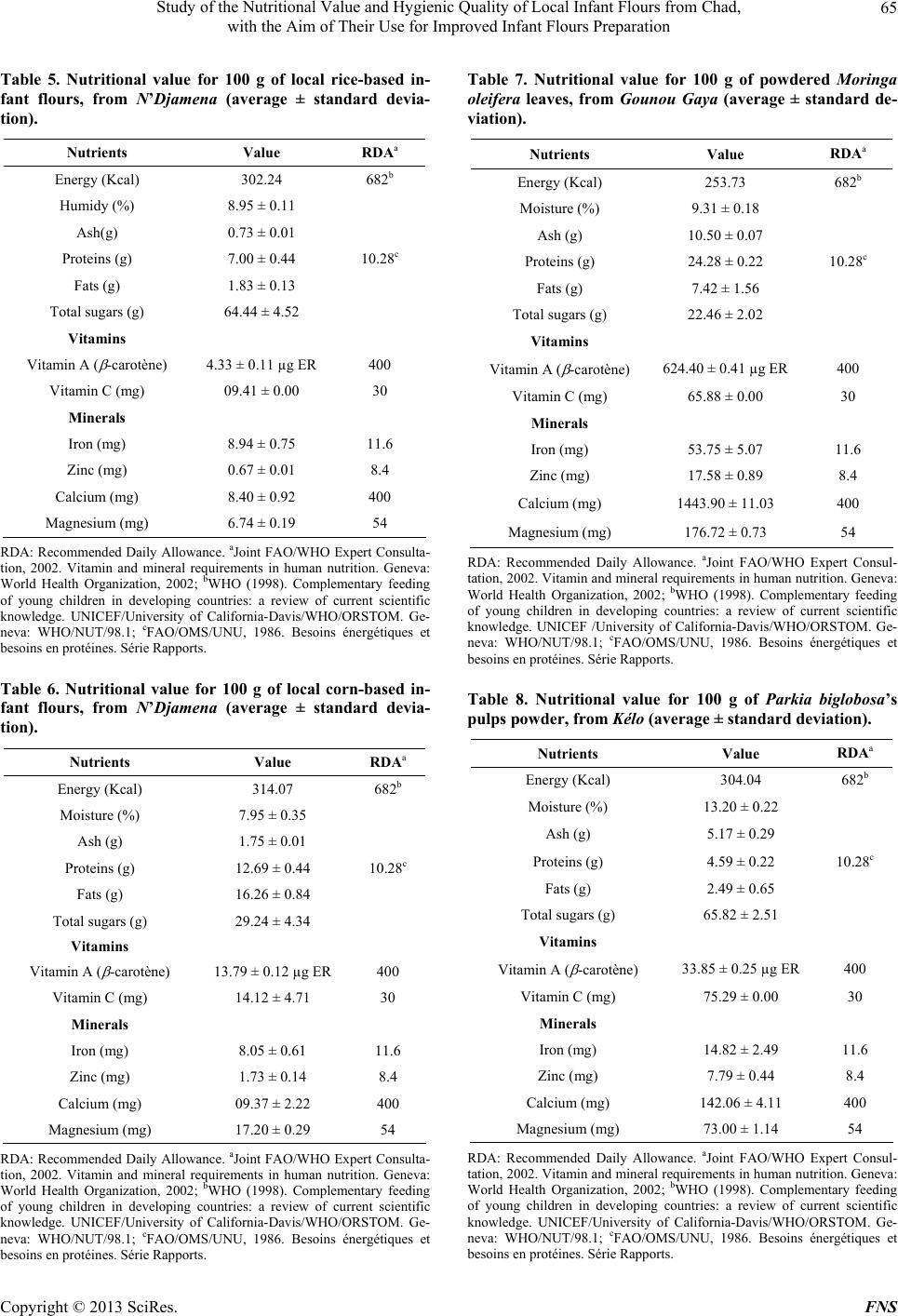 Study of the Nutritional Value and Hygienic Quality of Local Infant Flours from Chad, with the Aim of Their Use for Improved Infant Flours Preparation 65 Table 5. Nutritional value for 100 g of local rice-based in- fant flours, from N’Djamena (average ± standard devia- tion). Nutrients Value RDAa Energy (Kcal) 302.24 682b Humidy (%) 8.95 ± 0.11 Ash(g) 0.73 ± 0.01 Proteins (g) 7.00 ± 0.44 10.28c Fats (g) 1.83 ± 0.13 Total sugars (g) 64.44 ± 4.52 Vitamins Vitamin A ( -carotène) 4.33 ± 0.11 µg ER 400 Vitamin C (mg) 09.41 ± 0.00 30 Minerals Iron (mg) 8.94 ± 0.75 11.6 Zinc (mg) 0.67 ± 0.01 8.4 Calcium (mg) 8.40 ± 0.92 400 Magnesium (mg) 6.74 ± 0.19 54 RDA: Recommended Daily Allowance. aJoint FAO/WHO Expert Consulta- tion, 2002. Vitamin and mineral requirements in human nutrition. Geneva: World Health Organization, 2002; bWHO (1998). Complementary feeding of young children in developing countries: a review of current scientific knowledge. UNICEF/University of California-Davis/WHO/ORSTOM. Ge- neva: WHO/NUT/98.1; cFAO/OMS/UNU, 1986. Besoins énergétiques et besoins en protéines. Série Rapports. Table 6. Nutritional value for 100 g of local corn-based in- fant flours, from N’Djamena (average ± standard devia- tion). Nutrients Value RDAa Energy (Kcal) 314.07 682b Moisture (%) 7.95 ± 0.35 Ash (g) 1.75 ± 0.01 Proteins (g) 12.69 ± 0.44 10.28c Fats (g) 16.26 ± 0.84 Total sugars (g) 29.24 ± 4.34 Vitamins Vitamin A ( -carotène) 13.79 ± 0.12 µg ER 400 Vitamin C (mg) 14.12 ± 4.71 30 Minerals Iron (mg) 8.05 ± 0.61 11.6 Zinc (mg) 1.73 ± 0.14 8.4 Calcium (mg) 09.37 ± 2.22 400 Magnesium (mg) 17.20 ± 0.29 54 RDA: Recommended Daily Allowance. aJoint FAO/WHO Expert Consulta- tion, 2002. Vitamin and mineral requirements in human nutrition. Geneva: World Health Organization, 2002; bWHO (1998). Complementary feeding of young children in developing countries: a review of current scientific knowledge. UNICEF/University of California-Davis/WHO/ORSTOM. Ge- neva: WHO/NUT/98.1; cFAO/OMS/UNU, 1986. Besoins énergétiques et besoins en protéines. Série Rapports. Table 7. Nutritional value for 100 g of powdered Moringa oleifera leaves, from Gounou Gaya (average ± standard de- viation). Nutrients Value RDAa Energy (Kcal) 253.73 682b Moisture (%) 9.31 ± 0.18 Ash (g) 10.50 ± 0.07 Proteins (g) 24.28 ± 0.22 10.28c Fats (g) 7.42 ± 1.56 Total sugars (g) 22.46 ± 2.02 Vitamins Vitamin A ( -carotène) 624.40 ± 0.41 µg ER 400 Vitamin C (mg) 65.88 ± 0.00 30 Minerals Iron (mg) 53.75 ± 5.07 11.6 Zinc (mg) 17.58 ± 0.89 8.4 Calcium (mg) 1443.90 ± 11.03 400 Magnesium (mg) 176.72 ± 0.73 54 RDA: Recommended Daily Allowance. aJoint FAO/WHO Expert Consul- tation, 2002. Vitamin and mineral requirements in human nutrition. Geneva: World Health Organization, 2002; bWHO (1998). Complementary feeding of young children in developing countries: a review of current scientific knowledge. UNICEF /University of California-Davis/WHO/ORSTOM. Ge- neva: WHO/NUT/98.1; cFAO/OMS/UNU, 1986. Besoins énergétiques et besoins en protéines. Série Rapports. Table 8. Nutritional value for 100 g of Parkia biglobosa’s pulps powder, from Kélo (average ± standard deviation). Nutrients Value RDAa Energy (Kcal) 304.04 682b Moisture (%) 13.20 ± 0.22 Ash (g) 5.17 ± 0.29 Proteins (g) 4.59 ± 0.22 10.28c Fats (g) 2.49 ± 0.65 Total sugars (g) 65.82 ± 2.51 Vitamins Vitamin A ( -carotène) 33.85 ± 0.25 µg ER 400 Vitamin C (mg) 75.29 ± 0.00 30 Minerals Iron (mg) 14.82 ± 2.49 11.6 Zinc (mg) 7.79 ± 0.44 8.4 Calcium (mg) 142.06 ± 4.11 400 Magnesium (mg) 73.00 ± 1.14 54 RDA: Recommended Daily Allowance. aJoint FAO/WHO Expert Consul- tation, 2002. Vitamin and mineral requirements in human nutrition. Geneva: World Health Organization, 2002; bWHO (1998). Complementary feeding of young children in developing countries: a review of current scientific knowledge. UNICEF/University of California-Davis/WHO/ORSTOM. Ge- neva: WHO/NUT/98.1; cFAO/OMS/UNU, 1986. Besoins énergétiques et esoins en protéines. Série Rapports. b Copyright © 2013 SciRes. FNS  Study of the Nutritional Value and Hygienic Quality of Local Infant Flours from Chad, with the Aim of Their Use for Improved Infant Flours Preparation Copyright © 2013 SciRes. FNS 66 Table 9. CFU/g of different flora in the samples. FAMT Total Coliforms Therm. Colif E. coli Moulds Yeast Staph. Salm SK 5.8 × 104 0 0 0 250 0 0 - SB 3.4 × 104 250 0 0 375 750 0 - MN 4.6 × 104 750 0 0 0 750 0 - RN 1.3 × 104 3.7 × 103 0 0 250 0 0 - PN 2.3 × 104 104 0 0 750 750 0 - NK 5.2 × 104 250 0 0 0 500 0 - MG 9.5 × 103 0 0 0 125 250 0 - -: signifies an absence of salmonella; Therm. Colif = Themotolerant coliforms; Staph. = Staphylococcus aureus; Salm = Salmonella. Table 10. Microbiological standards for infant flours. Microorganisms/g of food Flours requiring cooking Instantaneous flours Aerobic mesophilic bacteria <105 <104 Fecal coliforms <100 <20 Escherichia coli <10 <2 Salmonella 0 0 Aflatoxins 0 0 Yeasts and moulds <103 Unspecified international recommendations, and with local legisla- tions in the countries where the flours is manufactured or sold. Table 10 presents the GRET and ORSTOM micro- biological specifications presented by [21]. Considering the microbiological standards above, the analyzed local flours show acceptable hygiene levels. However, work needs to be continued to raise awareness, amongst women producers, of particular issues such as drying conditions (protection against flies) and taking care of their hands when handling the flours. When searching for suspected pathogenic Staphylo- cocci, especially Staphylococcus aureus, some suspicious colonies were seen, but the coagulase was negative. 4. Discussion Analysis of the chemical composition, especially of ma- cronutrients, of local flours produced the results shown in the tables above. The moisture levels (%) in the flours vary from 6.54 ± 0.30 for PN to 8.95 ± 0.11 for RN, nearly all of which are one unit superior to those obtained by [6] in five infant flours called Vitafort, which were based on the same grains from Chad. The Vitafort meals had three ingredi- ents: cereals, cowpeas and peanut paste. Most homemade flours now also contain potato and carrot. The standards adopted on complementary feeding of young children [22] say that the water content should be less than 8 g per 100 g of flours. Only the rice-based flours (8.95 ± 0.11) seem to deviate from this. Its process should be reviewed to find the cause of this problem and to solve it. The study of the chemical composition shown in Ta- bles 2-6 sets out certain findings. Protein levels (7.00 ± 0.44 for RN to 12.69 ± 0.44 g per 100 g for MN) are lower than the values obtained by [6] (11.5 to 13.7 g per 100 g). However, for fats, with the exception of rice- based flours (1.83 ± 0.13 g per 100 g), our results (7.52 ± 0.35 for SK to 16, 26 ± 0.84 for MN) were superior to their own (5.5 to 8.5). Our results for total sugars ranged from 29.24 ± 4.34 for MN to 64.44 ± 4.52 for RN and energy levels (299.80 Kcal for SB to 385.84 Kcal for PN). The results recorded by [23], who worked on ten cereal-based complementary foods using extruded cere- als, roasted cereals and uncooked cereals, are higher than our results for these last two parameters. These were, respectively, sugars (66.2 to 80.17) and energy values (432 to 484 Kcal). The same is true for protein (10.32 to 14.6) and zinc (0.82 to 5.0). The analysis of micronutrients shows the richness of our flours in iron (7.11 ± 0.90 mg/100g for SK to 12.70 ± 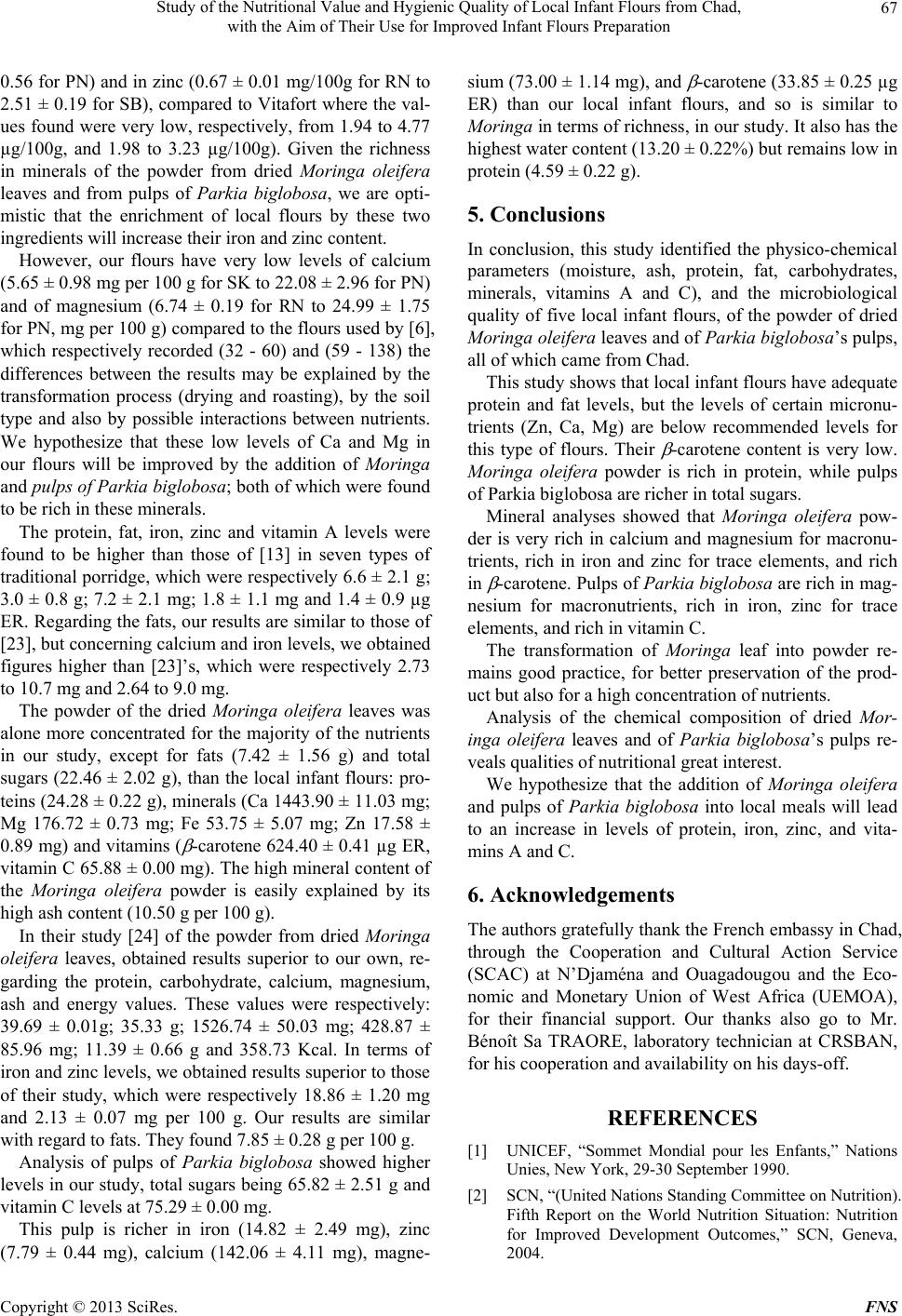 Study of the Nutritional Value and Hygienic Quality of Local Infant Flours from Chad, with the Aim of Their Use for Improved Infant Flours Preparation 67 0.56 for PN) and in zinc (0.67 ± 0.01 mg/100g for RN to 2.51 ± 0.19 for SB), compared to Vitafort where the val- ues found were very low, respectively, from 1.94 to 4.77 µg/100g, and 1.98 to 3.23 µg/100g). Given the richness in minerals of the powder from dried Moringa oleifera leaves and from pulps of Parkia biglobosa, we are opti- mistic that the enrichment of local flours by these two ingredients will increase their iron and zinc content. However, our flours have very low levels of calcium (5.65 ± 0.98 mg per 100 g for SK to 22.08 ± 2.96 for PN) and of magnesium (6.74 ± 0.19 for RN to 24.99 ± 1.75 for PN, mg per 100 g) compared to the flours used by [6], which respectively recorded (32 - 60) and (59 - 138) the differences between the results may be explained by the transformation process (drying and roasting), by the soil type and also by possible interactions between nutrients. We hypothesize that these low levels of Ca and Mg in our flours will be improved by the addition of Mo ringa and pulps of Parkia biglobosa; both of which were found to be rich in these minerals. The protein, fat, iron, zinc and vitamin A levels were found to be higher than those of [13] in seven types of traditional porridge, which were respectively 6.6 ± 2.1 g; 3.0 ± 0.8 g; 7.2 ± 2.1 mg; 1.8 ± 1.1 mg and 1.4 ± 0.9 µg ER. Regarding the fats, our results are similar to those of [23], but concerning calcium and iron levels, we obtained figures higher than [23]’s, which were respectively 2.73 to 10.7 mg and 2.64 to 9.0 mg. The powder of the dried Moringa oleifera leaves was alone more concentrated for the majority of the nutrients in our study, except for fats (7.42 ± 1.56 g) and total sugars (22.46 ± 2.02 g), than the local infant flours: pro- teins (24.28 ± 0.22 g), minerals (Ca 1443.90 ± 11.03 mg; Mg 176.72 ± 0.73 mg; Fe 53.75 ± 5.07 mg; Zn 17.58 ± 0.89 mg) and vitamins ( -carotene 624.40 ± 0.41 µg ER, vitamin C 65.88 ± 0.00 mg). The high mineral content of the Moringa oleifera powder is easily explained by its high ash content (10.50 g per 100 g). In their study [24] of the powder from dried Moringa oleifera leaves, obtained results superior to our own, re- garding the protein, carbohydrate, calcium, magnesium, ash and energy values. These values were respectively: 39.69 ± 0.01g; 35.33 g; 1526.74 ± 50.03 mg; 428.87 ± 85.96 mg; 11.39 ± 0.66 g and 358.73 Kcal. In terms of iron and zinc levels, we obtained results superior to those of their study, which were respectively 18.86 ± 1.20 mg and 2.13 ± 0.07 mg per 100 g. Our results are similar with regard to fats. They found 7.85 ± 0.28 g per 100 g. Analysis of pulps of Parkia biglobosa showed higher levels in our study, total sugars being 65.82 ± 2.51 g and vitamin C levels at 75.29 ± 0.00 mg. This pulp is richer in iron (14.82 ± 2.49 mg), zinc (7.79 ± 0.44 mg), calcium (142.06 ± 4.11 mg), magne- sium (73.00 ± 1.14 mg), and -carotene (33.85 ± 0.25 µg ER) than our local infant flours, and so is similar to Moringa in terms of richness, in our study. It also has the highest water content (13.20 ± 0.22%) but remains low in protein (4.59 ± 0.22 g). 5. Conclusions In conclusion, this study identified the physico-chemical parameters (moisture, ash, protein, fat, carbohydrates, minerals, vitamins A and C), and the microbiological quality of five local infant flours, of the powder of dried Moringa oleifera leaves and of Parkia biglobosa’s pulps, all of which came from Chad. This study shows that local infant flours have adequate protein and fat levels, but the levels of certain micronu- trients (Zn, Ca, Mg) are below recommended levels for this type of flours. Their -carotene content is very low. Moringa oleifera powder is rich in protein, while pulps of Parkia biglobosa are richer in total sugars. Mineral analyses showed that Moringa oleifera pow- der is very rich in calcium and magnesium for macronu- trients, rich in iron and zinc for trace elements, and rich in -carotene. Pulps of Parkia biglobosa are rich in mag- nesium for macronutrients, rich in iron, zinc for trace elements, and rich in vitamin C. The transformation of Moringa leaf into powder re- mains good practice, for better preservation of the prod- uct but also for a high concentration of nutrients. Analysis of the chemical composition of dried Mor- inga oleifera leaves and of Parkia biglobosa’s pulps re- veals qualities of nutritional great interest. We hypothesize that the addition of Moringa oleifera and pulps of Parkia biglobosa into local meals will lead to an increase in levels of protein, iron, zinc, and vita- mins A and C. 6. Acknowledgements The authors gratefully thank the French embassy in Chad, through the Cooperation and Cultural Action Service (SCAC) at N’Djaména and Ouagadougou and the Eco- nomic and Monetary Union of West Africa (UEMOA), for their financial support. Our thanks also go to Mr. Bénoît Sa TRAORE, laboratory technician at CRSBAN, for his cooperation and availability on his days-off. REFERENCES [1] UNICEF, “Sommet Mondial pour les Enfants,” Nations Unies, New York, 29-30 September 1990. [2] SCN, “(United Nations Standing Committee on Nutrition). Fifth Report on the World Nutrition Situation: Nutrition for Improved Development Outcomes,” SCN, Geneva, 2004. Copyright © 2013 SciRes. FNS 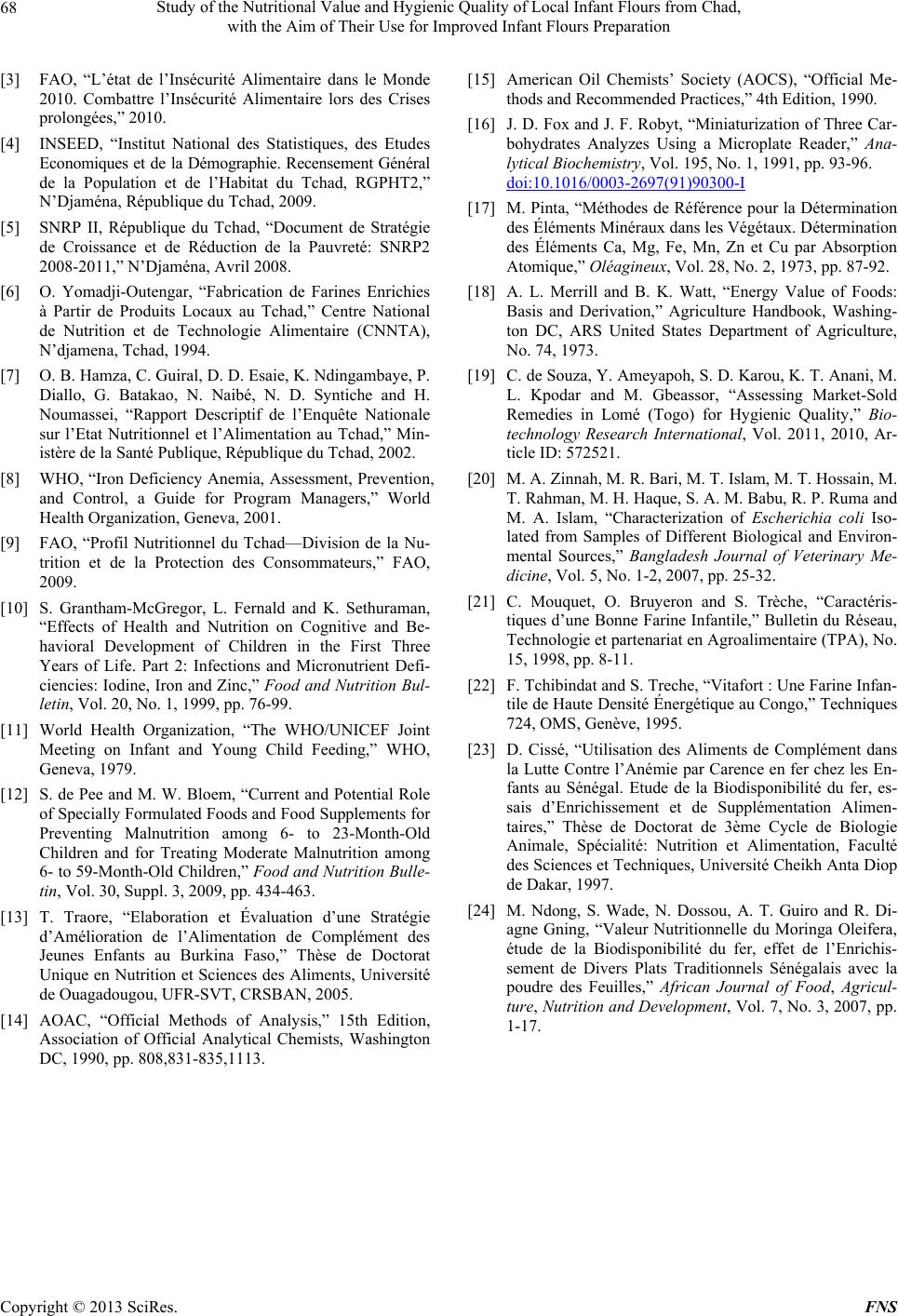 Study of the Nutritional Value and Hygienic Quality of Local Infant Flours from Chad, with the Aim of Their Use for Improved Infant Flours Preparation Copyright © 2013 SciRes. FNS 68 [3] FAO, “L’état de l’Insécurité Alimentaire dans le Monde 2010. Combattre l’Insécurité Alimentaire lors des Crises prolongées,” 2010. [4] INSEED, “Institut National des Statistiques, des Etudes Economiques et de la Démographie. Recensement Général de la Population et de l’Habitat du Tchad, RGPHT2,” N’Djaména, République du Tchad, 2009. [5] SNRP II, République du Tchad, “Document de Stratégie de Croissance et de Réduction de la Pauvreté: SNRP2 2008-2011,” N’Djaména, Avril 2008. [6] O. Yomadji-Outengar, “Fabrication de Farines Enrichies à Partir de Produits Locaux au Tchad,” Centre National de Nutrition et de Technologie Alimentaire (CNNTA), N’djamena, Tchad, 1994. [7] O. B. Hamza, C. Guiral, D. D. Esaie, K. Ndingambaye, P. Diallo, G. Batakao, N. Naibé, N. D. Syntiche and H. Noumassei, “Rapport Descriptif de l’Enquête Nationale sur l’Etat Nutritionnel et l’Alimentation au Tchad,” Min- istère de la Santé Publique, République du Tchad, 2002. [8] WHO, “Iron Deficiency Anemia, Assessment, Prevention, and Control, a Guide for Program Managers,” World Health Organization, Geneva, 2001. [9] FAO, “Profil Nutritionnel du Tchad—Division de la Nu- trition et de la Protection des Consommateurs,” FAO, 2009. [10] S. Grantham-McGregor, L. Fernald and K. Sethuraman, “Effects of Health and Nutrition on Cognitive and Be- havioral Development of Children in the First Three Years of Life. Part 2: Infections and Micronutrient Defi- ciencies: Iodine, Iron and Zinc,” Food and Nutrition Bul- letin, Vol. 20, No. 1, 1999, pp. 76-99. [11] World Health Organization, “The WHO/UNICEF Joint Meeting on Infant and Young Child Feeding,” WHO, Geneva, 1979. [12] S. de Pee and M. W. Bloem, “Current and Potential Role of Specially Formulated Foods and Food Supplements for Preventing Malnutrition among 6- to 23-Month-Old Children and for Treating Moderate Malnutrition among 6- to 59-Month-Old Children,” Food and Nutrition Bulle- tin, Vol. 30, Suppl. 3, 2009, pp. 434-463. [13] T. Traore, “Elaboration et Évaluation d’une Stratégie d’Amélioration de l’Alimentation de Complément des Jeunes Enfants au Burkina Faso,” Thèse de Doctorat Unique en Nutrition et Sciences des Aliments, Université de Ouagadougou, UFR-SVT, CRSBAN, 2005. [14] AOAC, “Official Methods of Analysis,” 15th Edition, Association of Official Analytical Chemists, Washington DC, 1990, pp. 808,831-835,1113. [15] American Oil Chemists’ Society (AOCS), “Official Me- thods and Recommended Practices,” 4th Edition, 1990. [16] J. D. Fox and J. F. Robyt, “Miniaturization of Three Car- bohydrates Analyzes Using a Microplate Reader,” Ana- lytical Biochemistry, Vol. 195, No. 1, 1991, pp. 93-96. doi:10.1016/0003-2697(91)90300-I [17] M. Pinta, “Méthodes de Référence pour la Détermination des Éléments Minéraux dans les Végétaux. Détermination des Éléments Ca, Mg, Fe, Mn, Zn et Cu par Absorption Atomique,” Oléagineux, Vol. 28, No. 2, 1973, pp. 87-92. [18] A. L. Merrill and B. K. Watt, “Energy Value of Foods: Basis and Derivation,” Agriculture Handbook, Washing- ton DC, ARS United States Department of Agriculture, No. 74, 1973. [19] C. de Souza, Y. Ameyapoh, S. D. Karou, K. T. Anani, M. L. Kpodar and M. Gbeassor, “Assessing Market-Sold Remedies in Lomé (Togo) for Hygienic Quality,” Bio- technology Research International, Vol. 2011, 2010, Ar- ticle ID: 572521. [20] M. A. Zinnah, M. R. Bari, M. T. Islam, M. T. Hossain, M. T. Rahman, M. H. Haque, S. A. M. Babu, R. P. Ruma and M. A. Islam, “Characterization of Escherichia coli Iso- lated from Samples of Different Biological and Environ- mental Sources,” Bangladesh Journal of Veterinary Me- dicine, Vol. 5, No. 1-2, 2007, pp. 25-32. [21] C. Mouquet, O. Bruyeron and S. Trèche, “Caractéris- tiques d’une Bonne Farine Infantile,” Bulletin du Réseau, Technologie et partenariat en Agroalimentaire (TPA), No. 15, 1998, pp. 8-11. [22] F. Tchibindat and S. Treche, “Vitafort : Une Farine Infan- tile de Haute Densité Énergétique au Congo,” Techniques 724, OMS, Genève, 1995. [23] D. Cissé, “Utilisation des Aliments de Complément dans la Lutte Contre l’Anémie par Carence en fer chez les En- fants au Sénégal. Etude de la Biodisponibilité du fer, es- sais d’Enrichissement et de Supplémentation Alimen- taires,” Thèse de Doctorat de 3ème Cycle de Biologie Animale, Spécialité: Nutrition et Alimentation, Faculté des Sciences et Techniques, Université Cheikh Anta Diop de Dakar, 1997. [24] M. Ndong, S. Wade, N. Dossou, A. T. Guiro and R. Di- agne Gning, “Valeur Nutritionnelle du Moringa Oleifera, étude de la Biodisponibilité du fer, effet de l’Enrichis- sement de Divers Plats Traditionnels Sénégalais avec la poudre des Feuilles,” African Journal of Food, Agricul- ture, Nutrition and Development, Vol. 7, No. 3, 2007, pp. 1-17.
|